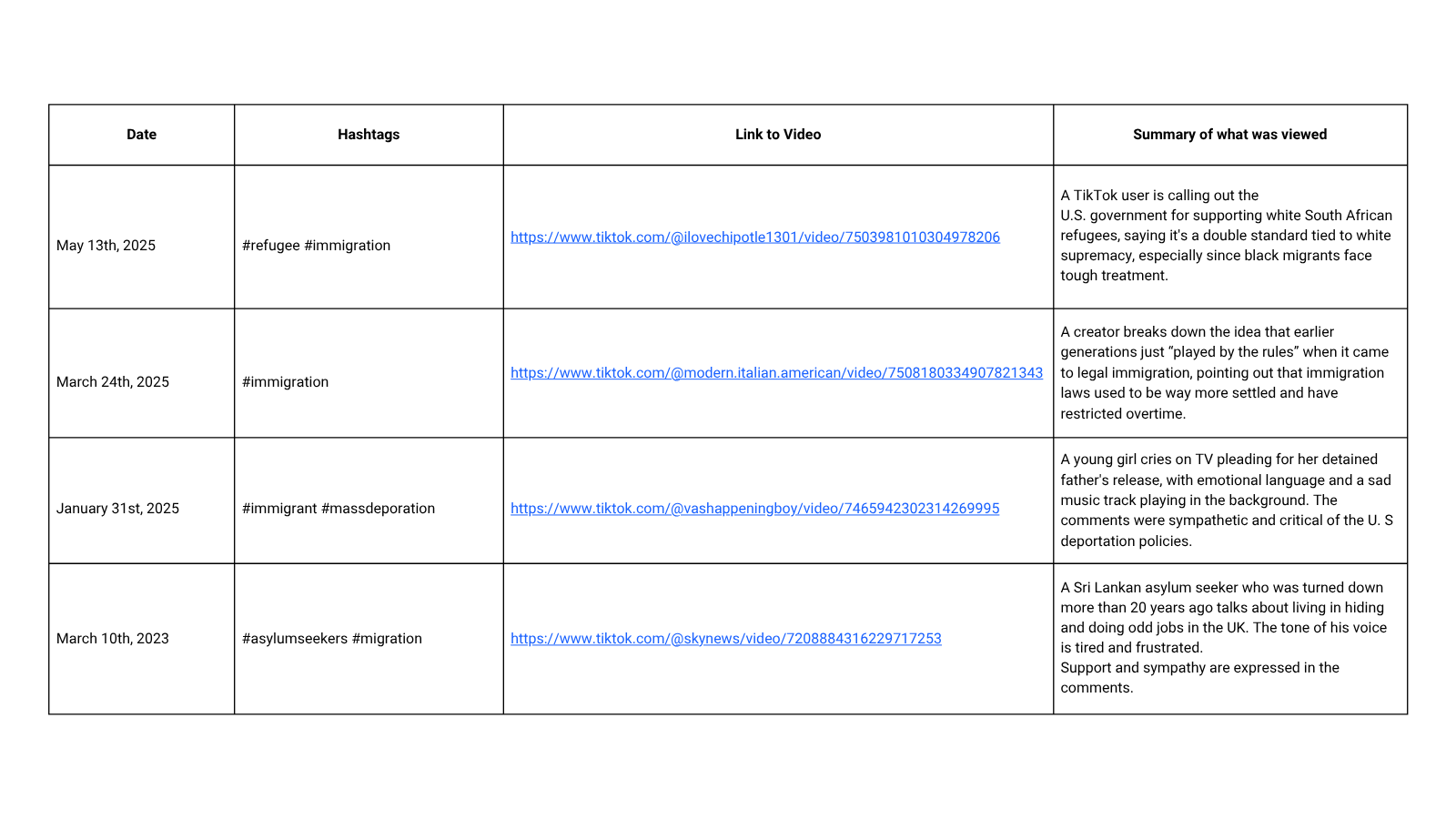A blog entry by Sukhmani Kalsi (INSPIRE 3II3 – C01)
Using hashtags like #immigration, #refugee, #mass deportation, and #Asylumseekers, this week’s TikTok search turned up compelling material that captures the variety of issues and inconsistencies that accompany migration politics. Every one of the four videos that were analyzed provides a unique perspective, ranging from historical analysis and critical political commentary to personal, emotional stories. Each video’s use of hashtags was deliberate, they shaped how viewers interacted with and interpreted the posts while also establishing the content within larger migration stories. When taken as a whole, these videos show how TikTok has evolved into a site where migration is not only recorded but also disputed, reinterpreted, and challenged.
A criticism of the U.S government’s accelerated assistance for white South African refugees was presented in the first video using the hashtags #immigration and #refugee. The creator passionately questioned why white South African landowners were accorded preferential protection in a country that still deports and criminalizes black and brown migrants. The posts’ overtly political and racially charged criticism of refugee policy, which exposes the hypocrisy that exists in humanitarian discourse, made it stand out. The tone was serious and angry, reflecting the course discussions about how race, geopolitics, and selective empathy shape migration governance. Instead of being a mere category, the hashtag #refuge was used as a weapon to highlight the inconsistency in who is considered deserving of asylum.
The second video, which was solely tagged with the hashtag #immigration, dispelled the misconception that previous generations of emigrants “followed the rules”. During the Ellis Island era, U.S immigration was practically an open-door policy, the creator explained in a humorous yet educated manner. The majority of European immigrants were spared from background checks, language exams, and visa sponsorship. The post’s tone was more ironic and educational, but the hashtag #immigration linked it to current discussions about justice and legality. This video brought to mind how historical amnesia can influence modern immigration discourse, which is something we had briefly talked about in class, where we discussed how people frequently overlook changes in policy over time. The video was used to show how “whiteness” and historical timing affected who was able to migrate with ease and who is now subject to intense scrutiny. The third video, in sharp contrast, showed a young girl crying on national television as she begged for her father’s release after he was detained for depression. The hashtags #immigration and #massdeportation were used to essentially show the “human cost” of deportation and how families are affected by this. The video was extremely raw and emotional, with gentle music playing in the background that accentuated the distress, in contrast to the first two videos, which were more illustrative. The child’s words were heartbreaking, clumsy, and ill-practiced. With sentiments like “bring her dad back” and “shame on you, America”, the comment section was overwhelmingly sympathetic. The way that the hashtag #massdeporation turned the personal story into a more political issue, which urged the viewers to view this child’s grief as a component of a larger systemic issue rather than a single example of deportation, was especially powerful. Themes that are frequently ignored in policy discussions and the role of children in migration stories are all in line with some decisions we’ve had in class and breakout room discussions.
The fourth video followed Kanagasabapathy, a Sri Lankan asylum seeker who has been hiding in the UK since his claim was denied almost twenty years ago. The video examined what it’s like to live in a legal battle and was tagged with #asylumseekers and #migration. He explained that working odd jobs while evading immigration authorities constitutes his “normal life”. The video, which was already disturbing enough, was more disturbing because the tone was subtle and slightly teary rather than overly emotional or angry. His fragile situation was directly related to the hashtags used, which were #asylumseekers, putting him in a mere category, while #migration increased the posts’ popularity to a worldwide audience. Despite their support for him, the comment insulted many migrants, with users pointing out that “at least he’s working”. Many of these backhanded comments were said, which essentially lessened the pain and suffering of what he had experienced to a broader discussion of how immigrants take advantage of these systems, which was not the point of the video.
When these videos are compared, several parallels and differences are shown. All of them used hashtags as framing devices, serving as more than just searchable terms. They indicated not only the subject matter of the videos but also how viewers are to understand them. Videos tagged with #immigration and #massdeportation focused on political criticism or emotional appeals. On the other hand, videos tagged with #refugees and #asylumseekers tended to focus on legality and humanitarian need. The question of who is deemed worthy of protection, dignity, or inclusion, ran throughout all of the videos despite their distinct geographic regions, like the U.S. and U.K., Being “legal” doesn’t always equate to fair treatment, and not having documentation does not imply that one is less valuable or important. This conflict between legality and justice was also evident.
I found it surprising that the stakes of migration could be conveyed with equal effectiveness using a variety of tones, including anger, education, sadness, and resignation. Whether someone was addressing racism, reciting legal precedent, or speaking through tears, their message was based on personal experience. Though they also reflected polarization, particularly when legal status or race were brought up, the comment sections frequently turned into places of solidarity. This online discussion resembles course topics about social media portrayals, voice politics, and the emotional burden migrants bear in defending their presence.
Essentially, the videos this week demonstrate how TikTok serves as a platform for political resistance as well as storytelling. It is used by migrants and their allies to tell stories that are frequently missing from social media, using hashtags that convey every emotion, seriousness, and legality. In doing so, they challenge current stories and serve as a reminder that online comments sections, captions, and calls for justice are just as important in the politics surrounding migration as are courts and legislatures.

